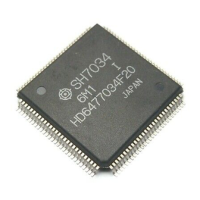421
Table 14.4 A/D Conversion Time (Single Mode)
CKS = 0 CKS = 1
Item Symbol Min Typ Max Min Typ Max
A/D start delay t
D
10 — 17 6 — 9
Input sampling time t
SPL
—64— —32—
Total A/D conversion time t
CONV
259 — 266 131 — 134
Note: Values are the number of states (tcyc).
14.4.4 A/D Conversion Start by External Trigger Input
The A/D converter can be started when an external trigger is input. The external trigger is input
from the ADTRG input pin when the trigger enable (TRGE) bit in the A/D control register
(ADCR) is set to 1. When the ADTRG input pin is asserted low, the A/D start (ADST) bit in the
A/D control/status register (ADCSR) is set to 1 and A/D conversion begins. All other operations
are the same as when the ADST bit is set to 1, regardless of whether the mode is single or scan.
For the timing, see figure 14.6.
A/D conversion
CK
ADTRG
External
trigger signal
ADST
Figure 14.6 External Trigger Input Timing
14.5 Interrupts and DMA Transfer Requests
The A/D converter can generate an A/D interrupt (ADI) request at the end of conversion. The ADI
request is enabled by setting the ADIE bit in ADCSR to 1, or is disabled by clearing the bit to 0.
When ADI is generated, the DMAC can be started. DMA transfers can be performed by
requesting an ADI interrupt by setting the resource select bits (RS3–RS0) in the DMA channel
control register (CHCR) of the direct memory access controller (DMAC). The ADF bit in the A/D
control/status register (ADCSR) is automatically cleared to 0 when the DMAC accesses an A/D
converter register.

